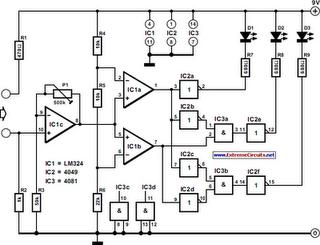Home » Circuits
Three-State Continuity Tester
The continuity tester can distinguish between high-, medium-, and low-resistance connections. When there is a conductance between the inputs, which are linked to small probes, a current flows from the +9 V line to earth via R1 and R2. The consequent potential difference, p.d., across R2 is used to determine the transfer resistance. Operational amplifier IC1c amplifies the p.d. across R2 to a degree that is set with P1. A window comparator, IC1a and IC1b, likens the output of IC1c to the two levels set with potential divider R4–R6. Depending on the state of the outputs of the two comparators, three light-emitting diodes (LEDs) are driven via the gates and inverters contained in IC3 and IC2 respectively in such a way that they indicate the transfer resistance in three categories.Circuit diagram:

When the resistance is high, green diode D3 lights; when it is of medium value, yellow diode D2 lights, and when it is low, red diode D1 lights. The levels at which the diodes light is set with P1, but note that in any case the minimum value depends on the p.d. across R2. It is possible to reduce the value of the p.d. to enable lower transfer resistances to be detected, but this would mean an increase in the test current through R2. With values as specified, the circuit in its quiescent state draws a current of about 17 mA, but in operation each LED adds about 10 mA to this. The LM324 (IC1) may be operated from a single supply line: R1 prevents the voltage at the input from reaching the level of the supply line (which is not permissible). The supply voltage may be 5–18 V. The LEDs are driven directly by the inverters in the 4049 (IC2), which can switch currents of up to 20 mA to earth.
